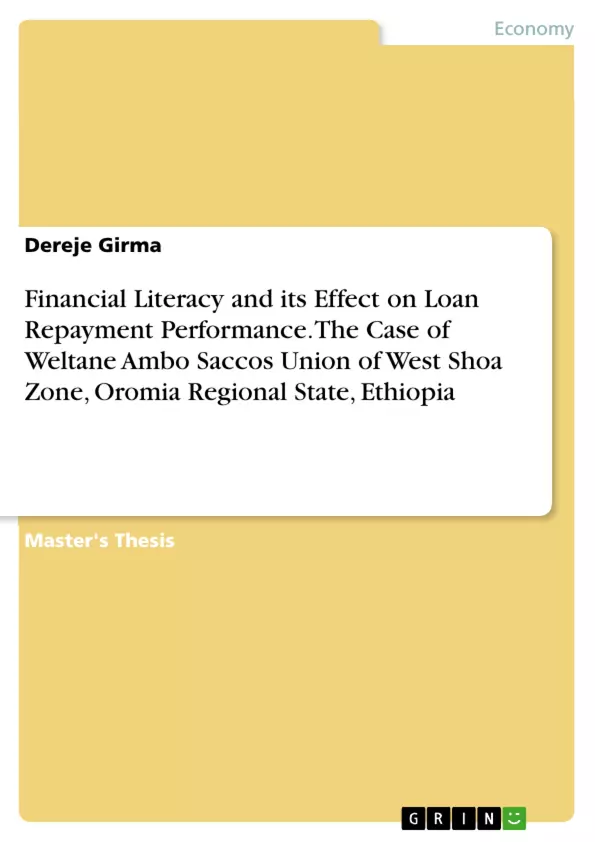The main objective of the study was to assess the effect of financial literacy on loan repayment performance in case of Weltane Ambo SACCOs Union. The specific objectives will include to examine the effect of financial budgeting literacy on loan repayment in the study area, to evaluate the effect of debt management literacy on loan repayment in the study area, to examine effect of finance literacy on loan repayment in the study area and to assess the current loan repayment status of WASACCOsU.
The study has several significances, for the SACCOs in identifying effect of financial literacy on loan repayment performance and for the members to understand about their financial knowledge on their saving and loan repayment. For others the project findings and recommendation may be helpful for further research. The study will be important to the academicians and researchers who can use it as a springboard for other researches/studies. It gives guide lines for policy makers, SACCOs and stakeholders about existing financial literacy and its effect on loan repayment performance. It helps institutions to use as inputs for preparing training for their employees and members of the society.
Inhaltsverzeichnis (Table of Contents)
- ACKNOWLEDGEMENTS
- Table of Contents
- List of Tables
- List of Figures
- LIST OF ACRONYMS AND ABBREVIATIONS
- ABSTRACT
- CHAPTER ONE
- INTRODUCTION
- Introduction
- 1.1 Background of the study
- 1.1.1 Background of Weltane Ambo SACCOS Union
- 1.2 Statement of the problem
- 1.3 Objectives of the study
- 1.3.1 General Objectives
- 1.3.2 Specific Objectives
- 1.4. Research Questions
- 1.5 Significance of the study
- 1.6 Scope of the study
- 1.7 Limitation of the study
- 1.8 Organization of the paper
- CHAPTER TWO
- LITERATURE REVIEW
- Introduction
- 2.1 Theoretical reviews
- 2.1.1 Financial literacy
- 2.1.2 Importance of financial literacy
- 2.1.3 Findings on financial literacy
- 2.2 Cooperative Education
- 2.3 Saving and credit cooperatives
- 2.4 Effect of finance literacy on loan repayment
- 2.5 Loan Default Rate in SACCOS
- 2.6 The 5 Cs of Credit
- 2.7 Empirical reviews
- 2.8 Research Gap
- 2.9 Conceptual framework
- CHAPTER THREE
- RESEARCH METHDOLOGY
- Introduction
- 3.1 Description of The study Area
- 3.2 Research design
- 3.3 Study area and population
- 3.4 Source and nature of data
- 3.5 Determination of sample size
- 3.7 Sampling techniques
- 3.8 Data collection instruments
- 3.9 Data collection procedures
- 3.10 Data Analysis
- 3.10.1 Multiple Regression Model Specification
- CHAPTER FOUR
- RESULTS AND DISCUSSION
- 4.1 The results of descriptive analysis
- 4.2 Financial literacy and Loan repayment
- 4.3 Interview Discussion
- 4.4 Correlation Analysis
- 4.5 Regression Analysis
- 4.6 Discussion
- 4.6.1: Influence of finance literacy on loan repayment
- 4.6.2: Influence of Budgeting literacy in loan repayment
- 4.6.3: Influence of debt management literacy on loan repayment WASACOSU
- CHAPTERR FIVE
- FINDINGS, CONCLUSION AND RECOMMENDATIONS
- 5.2. CONCLUSIONS
- 5.3 RECOMMENDATIONS
- References
- APPENDIXES II Questions for Focus Group Discussion
Zielsetzung und Themenschwerpunkte (Objectives and Key Themes)
This thesis investigates the relationship between financial literacy and loan repayment performance among members of the Weltane Ambo SACCOS Union in West Shoa Zone, Oromia Regional State, Ethiopia. The study aims to explore the impact of financial literacy on loan repayment behavior and identify factors that influence loan default rates within the cooperative setting. It also seeks to contribute to the understanding of financial literacy in a developing country context.
- Financial literacy and its influence on loan repayment performance
- Factors contributing to loan default rates in SACCOS
- The role of financial literacy in cooperative education and development
- The impact of financial literacy on individual and collective financial well-being
- Policy implications and recommendations for improving financial literacy in the cooperative sector
Zusammenfassung der Kapitel (Chapter Summaries)
Chapter One: Introduction provides an overview of the study, outlining the background of the research, the problem statement, and the objectives. It also discusses the significance of the study, its scope, limitations, and the organization of the paper.
Chapter Two: Literature Review examines existing research on financial literacy, cooperative education, saving and credit cooperatives, and the effect of financial literacy on loan repayment. This chapter explores theoretical frameworks, empirical findings, and research gaps related to the topic.
Chapter Three: Research Methodology details the methods employed in the study, including the research design, study area, population, data collection instruments, and data analysis techniques.
Chapter Four: Results and Discussion presents the findings of the research, including descriptive analysis, correlation analysis, and regression analysis. This chapter analyzes the relationship between financial literacy and loan repayment performance and discusses the implications of the results.
Chapter Five: Findings, Conclusion and Recommendations summarizes the key findings of the study, draws conclusions based on the research, and provides recommendations for improving financial literacy and loan repayment performance within the cooperative sector.
Schlüsselwörter (Keywords)
The primary focus of this thesis lies in the interplay between financial literacy and loan repayment within the context of cooperative societies in Ethiopia. Key terms and concepts explored include financial literacy, loan repayment performance, cooperative education, SACCOS (Saving and Credit Cooperative Societies), and loan default rates. The study delves into the impact of financial literacy on individual and collective financial well-being, exploring the influence of factors such as budgeting literacy and debt management literacy. Ultimately, the research aims to contribute to the understanding of financial literacy in a developing country context and to inform policy decisions for improving financial inclusion and cooperative development.
- Quote paper
- Dereje Girma (Author), 2021, Financial Literacy and its Effect on Loan Repayment Performance. The Case of Weltane Ambo Saccos Union of West Shoa Zone, Oromia Regional State, Ethiopia, Munich, GRIN Verlag, https://www.grin.com/document/1023406



